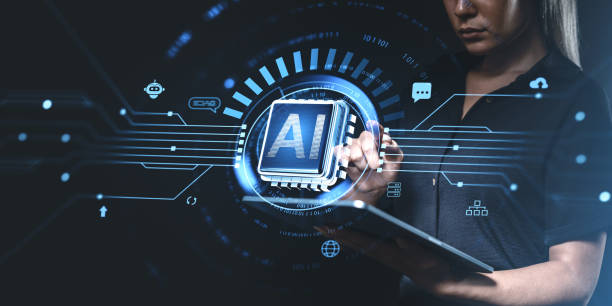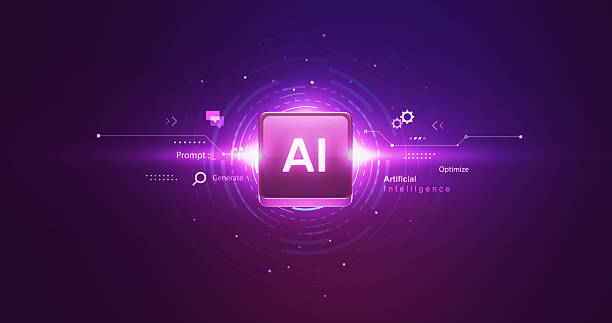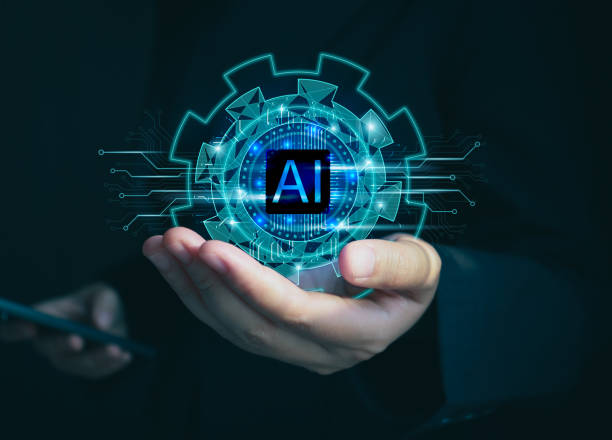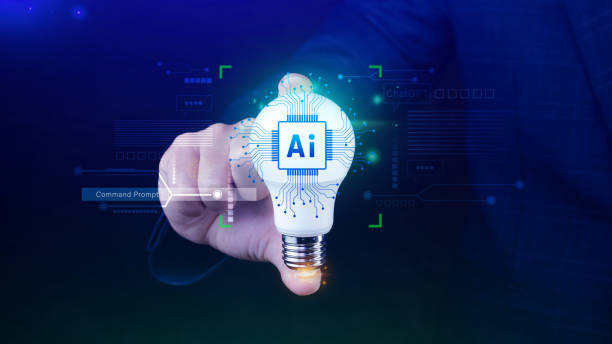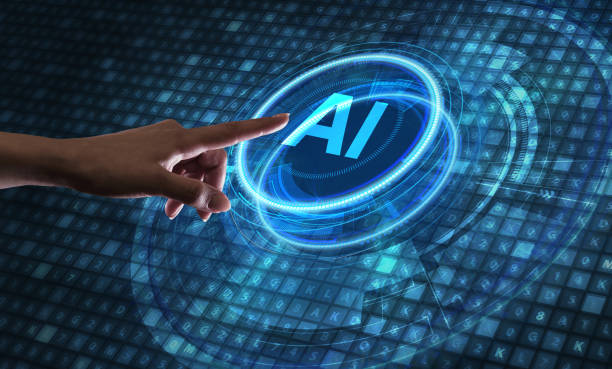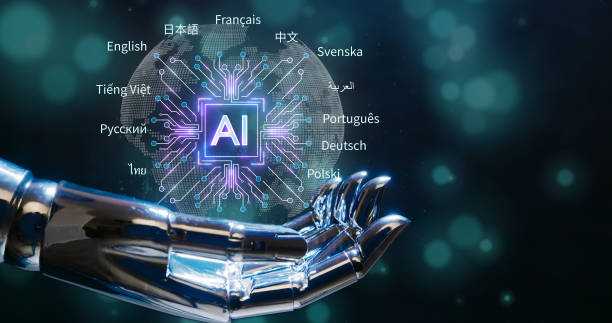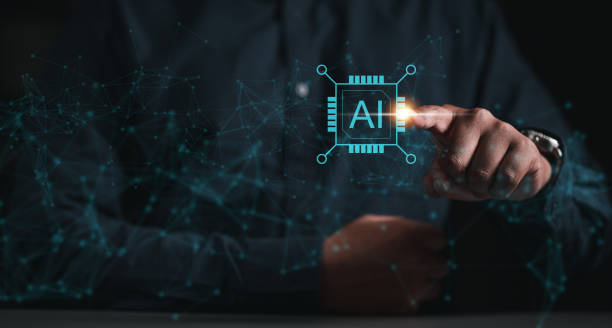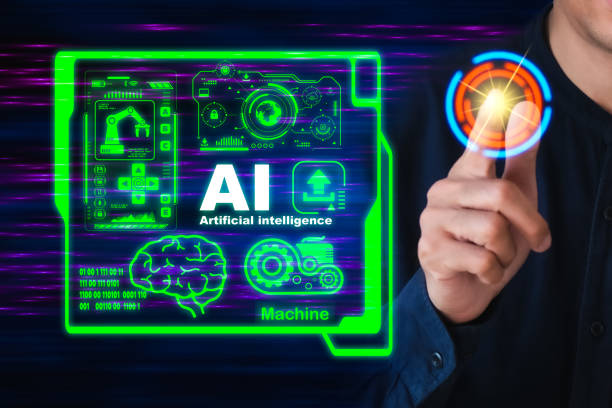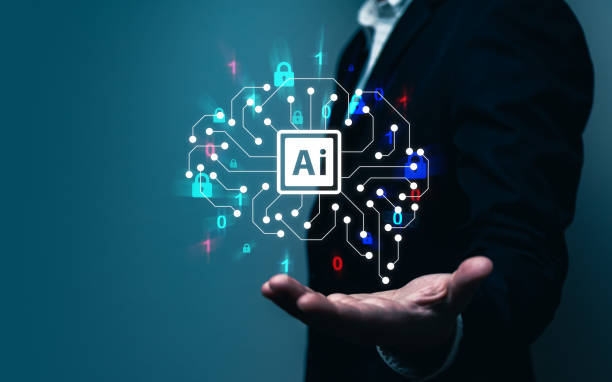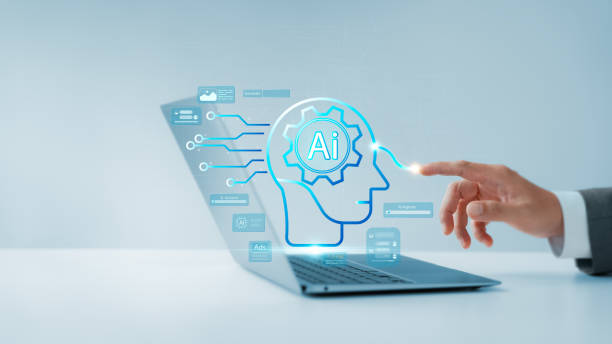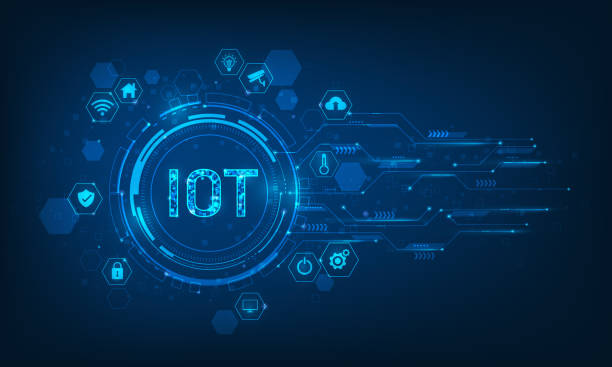What is an Artificial Intelligence Robot? Definition and Basic Concepts
#Artificial Intelligence Robot is a combination of two distinct fields of science and technology: robotics and artificial intelligence.
Simply put, an AI robot is a physical machine (robot) that, through algorithms and AI models, is capable of performing tasks that typically require human intelligence.
These tasks can include learning, reasoning, problem-solving, understanding natural language, pattern recognition, and decision-making.
In other words, artificial intelligence allows robots to act beyond pre-programmed plans and interact intelligently with their environment.
To better understand this concept, it is necessary to pay attention to the difference between traditional robots and AI robots.
Traditional robots usually operate based on pre-determined and programmed instructions and are not able to adapt to new or unexpected conditions.
In contrast, AI robots, using machine learning algorithms and other AI techniques, are able to learn from data, adapt to new conditions, and make independent decisions.
For example, a traditional industrial arm robot designed for welding parts can only repeat the same task over and over.
But an AI robot designed for the same job can learn how to optimize welding parameters and improve the quality of work by analyzing data related to weld quality.
Also, it can automatically detect and take appropriate action if a problem occurs in the welding process.
Does your current website convert visitors into customers or scare them away? Solve this problem forever with professional corporate website design by Rasaweb!
✅ Create strong credibility and branding
✅ Attract target customers and increase sales
⚡ Get a free consultation now!
Main Components of an Artificial Intelligence Robot
An AI robot consists of several main components, which include:
- Hardware including the robot’s body, motors, sensors, cameras, and other physical parts that allow the robot to move, interact with the environment, and collect information.
- Software including the operating system, hardware drivers, and artificial intelligence algorithms that allow the robot to control the hardware, process data, and perform tasks.
- Artificial intelligence algorithms including machine learning models, neural networks, expert systems, and other AI techniques that allow the robot to learn, reason, solve problems, and make decisions.
- Data including information collected by sensors and cameras, training data, and other information that allows the robot to learn and improve performance.
Click here to preview your posts with PRO themes ››
These components work together to form an intelligent agent capable of performing complex tasks and interacting intelligently with the environment.
Proper selection and configuration of these components depends on the desired application and purpose of the robot.
Diverse Applications of Artificial Intelligence Robots
The applications of #Artificial Intelligence Robot are very broad and diverse and can be used in almost every area of human life.
Some of the most important applications of AI robots include:
- Industry Use of AI robots in production lines, warehousing, logistics and other industrial processes to increase productivity, reduce costs and improve quality.
- Medicine Use of surgical robots, rehabilitation robots, nurse robots and other AI robots in diagnosing diseases, performing precise surgeries, providing medical care and rehabilitating patients.
- Services Use of service robots in hotels, restaurants, shops and other service centers to provide services to customers, guide visitors and perform repetitive tasks.
- Agriculture Use of agricultural robots in planting, maintaining and harvesting agricultural products to increase productivity, reduce water and fertilizer consumption, and improve product quality.
- Military Use of military robots in reconnaissance, bomb disposal, patrolling and other military operations to reduce risks for soldiers and increase the efficiency of operations.
- Space Use of space robots in exploring planets, repairing satellites and performing other space activities to reduce costs and risks for astronauts.
These are just a few examples of the many applications of AI robots.
With the advancement of technology, it is expected that the applications of these robots will become more extensive and diverse in the future.
| Application Area | Example |
|---|---|
| Industry | Automated welding robots |
| Medicine | Da Vinci surgical robot |
| Services | Food delivery robots |
Advantages of Using Artificial Intelligence Robots
The use of #Artificial Intelligence Robot has many advantages, including:
- Increased Productivity AI robots can perform tasks faster and more accurately than humans, thereby increasing productivity.
- Reduced Costs AI robots can reduce labor, energy, and raw material costs.
- Improved Quality AI robots can perform tasks with higher quality than humans, thereby improving the quality of products and services.
- Increased Safety AI robots can perform dangerous tasks without endangering human lives.
- Performing Repetitive Tasks AI robots can perform repetitive and tedious tasks without fatigue and reduced accuracy.
- Improved Decision Making AI robots can make better decisions than humans by analyzing data.
These advantages have led to AI robots being increasingly used in various industries and applications.
Are you dissatisfied with the low sales of your online store?
Rasaweb is your solution for having a professional and high-selling online store.
✅ Significant increase in sales and revenue
✅ Easy and enjoyable shopping experience for customers
⚡ Get a free consultation from Rasaweb now!
Challenges Facing the Development of Artificial Intelligence Robots
Despite the many advantages, the development of #Artificial Intelligence Robot also faces challenges, including:
- High Cost The design, construction, and maintenance of AI robots is usually expensive.
- Technical Complexity Developing AI algorithms and integrating them with robot hardware is a complex and specialized process.
- Need for Large Amounts of Data Machine learning algorithms require large amounts of data for training and improving performance.
- Ethical Concerns The use of AI robots can lead to ethical concerns such as job losses, discrimination, and abuse.
- Security Issues AI robots can be targeted by cyber attacks and abused.
To overcome these challenges, it is necessary to invest in research and development, train skilled workforce, and develop appropriate laws and regulations.
The Future of Artificial Intelligence Robots
The future of #Artificial Intelligence Robot looks very bright and promising.
With the advancement of technology, AI robots are expected to become smarter, more capable, and cheaper, resulting in their applications becoming more widespread.
Some predictions about the future of AI robots include:
- Expanding the Use of Robots in Homes Home robots capable of performing tasks such as cleaning, cooking, caring for children and the elderly will become increasingly popular.
- Developing Self-Driving Robots Self-driving cars, self-driving drones and other self-driving vehicles will transform the way we travel.
- Using Robots in Education Educational robots capable of providing personalized and interactive education will help improve the quality of education.
- Developing Collaborative Robots Robots capable of collaborating with humans in work environments will help increase productivity and improve working conditions.
- Developing Humanoid Robots Humanoid robots capable of mimicking human behavior and movements will be used in applications such as customer service, healthcare, and recreation.
However, it is necessary to keep in mind that the development of AI robots should be done with ethical, social and security considerations to prevent misuse of this technology.
Machine Learning and its Role in Artificial Intelligence Robots
Machine Learning is one of the main subfields of artificial intelligence and plays a very important role in the development of #Artificial Intelligence Robot.
Machine learning allows robots to learn from data without being explicitly programmed.
In other words, robots can improve their abilities and perform new tasks by observing data and patterns within them.
Machine learning algorithms allow robots to:
- Pattern Recognition Recognize patterns in data and use them for prediction and decision making.
- Learning from Experience Learn from past experiences and improve performance in the future.
- Adapting to New Conditions Adapt to new and unexpected conditions and perform tasks effectively.
For example, an AI robot trained to recognize images can recognize objects in new images by observing them and making decisions based on them.
Also, an AI robot trained to play chess can learn new strategies and improve its performance by playing with different opponents.
| Type of Machine Learning Algorithm | Application in Artificial Intelligence Robot |
|---|---|
| Supervised Learning | Object detection, image classification |
| Unsupervised Learning | Data clustering, anomaly detection |
| Reinforcement Learning | Robot control, path planning |
Artificial Intelligence Robots in Iran: Current Status and Outlook
In Iran, the field of #Artificial Intelligence Robot has made significant progress in recent years.
Many universities and research centers are conducting research and development in this field, and knowledge-based companies are also producing AI robots for various applications.
Some of the most important areas of activity in the field of AI robots in Iran include:
- Industrial Robots Production of industrial robots for use in production lines, warehousing and other industrial processes.
- Service Robots Production of service robots for use in hotels, restaurants, shops and other service centers.
- Educational Robots Production of educational robots for use in schools and universities.
- Medical Robots Production of medical robots for use in diagnosing diseases, performing surgeries, and providing medical care.
However, the development of AI robots in Iran also faces challenges, including a lack of investment, skilled workforce, and appropriate infrastructure.
To develop this field, it is necessary for the government and the private sector to cooperate and make the necessary investments and provide the required infrastructure.
Given Iran’s high potential in the field of artificial intelligence and robotics, it is expected that we will witness significant progress in this field in the near future.
AI robots can have a great impact on human life.
Are you disappointed with the low conversion rate of your online store? Rasaweb turns your online store into a powerful tool for attracting and converting customers!
✅ Significantly increase the conversion rate of visitors to buyers
✅ Unparalleled user experience to increase customer satisfaction and loyalty⚡ Get free advice from Rasaweb!
Case Study: Artificial Intelligence Robots in Industry
One of the prominent examples of the application of #Artificial Intelligence Robot in industry is its use in the quality control process.
In the past, product inspection on the production line was done manually, which was time-consuming, expensive, and prone to errors.
But by using AI robots equipped with machine vision systems, product inspection can be done automatically and with very high accuracy.
These robots can take accurate images of products using high-quality cameras and use machine learning algorithms to detect defects and imperfections in them.
This increases inspection speed, reduces costs and improves product quality.
In addition, AI robots can collect data on product defects and analyze them to identify the cause of these defects and provide solutions to prevent them.
For example, an auto parts manufacturer can use AI robots to inspect the parts produced on the production line.
These robots can detect potential defects such as cracks, scratches, and non-compliance with standards by checking the dimensions, shape, and appearance of the parts and remove the defective parts from the production line.
This prevents defective parts from entering the market and increases customer satisfaction.
AI robots will help us.
How to Design an Artificial Intelligence Robot
Designing an #Artificial Intelligence Robot is a complex and multi-stage process that requires knowledge and expertise in various fields including robotics, artificial intelligence, programming, and electronics.
Here is a general guide to designing an AI robot:
- Determine the Goal and Application First, you must determine the goal and application of the robot.
What is the robot designed for? What environment will it work in? What tasks should it perform? - Hardware Selection After determining the goal and application, you must select the appropriate hardware.
This includes the robot’s body, motors, sensors, cameras, processors and other physical parts. - Software Selection After selecting the hardware, you must select the appropriate software.
This includes the operating system, hardware drivers, AI libraries, and software development tools. - Development of Artificial Intelligence Algorithms After selecting the software, you must develop the required AI algorithms.
This includes machine learning algorithms, neural networks, expert systems, and other AI techniques. - Hardware and Software Integration After developing AI algorithms, you must integrate the hardware and software with each other.
This includes writing code to control hardware, process data, and execute AI algorithms. - Testing and Evaluation After integrating hardware and software, you must test and evaluate the robot.
This includes checking the robot’s performance in various conditions, identifying and fixing bugs, and optimizing the robot’s performance.
These steps provide an overview of the design process of an AI robot.
Each step requires specific knowledge and expertise and may need to be repeated and reviewed.
AI robots for a better future.
Frequently Asked Questions
| Question | Answer |
|---|---|
| What is an Artificial Intelligence Robot? | It is a robot that uses the capabilities of artificial intelligence to understand the environment, reason, learn and make decisions to perform complex tasks independently. |
| What is the main difference between a regular robot and an AI robot? | AI robots can learn and adapt to their environment, while regular robots usually operate based on fixed and pre-determined programming. |
| In what areas are AI robots used? | In areas such as industry (production lines), medicine (robotic surgery), services (customer support, smart vacuum cleaners), exploration (space and underwater) and entertainment. |
| How do AI robots learn? | They gain new skills through machine learning algorithms (Machine Learning) and deep learning (Deep Learning), by analyzing large data and identifying patterns. |
| Can AI robots have emotions? | Currently, no. They can identify or simulate emotions, but they do not have a real experience of emotions like humans. |
| What are the most important advantages of using AI robots? | Increased productivity, reduced human error, performing dangerous or repetitive tasks, and providing innovative and efficient services. |
| What challenges are there in developing AI robots? | The need for large amounts of high-quality data, algorithm complexity, ethical issues, cybersecurity, and high research and development costs. |
| Are AI robots dangerous to humans? | By following the principles of safe design and ethical regulations, no. Concerns are more related to social and economic impacts such as changes in the labor market. |
| What is an example of an AI robot in everyday life? | Smart vacuum cleaners (such as Roomba) that automatically map and clean the house, or smart voice assistants (such as Siri and Alexa). |
| How is the future of AI robots predicted? | They are expected to become smarter, more autonomous, and able to interact more complexly with humans and play a more prominent role in industry, medicine, transportation, and everyday life. |
And other services of Rasa Web advertising agency in the field of advertising
Intelligent Data Analysis: Designed for businesses looking to increase click-through rates through dedicated programming.
Intelligent Website Development: A professional solution for attracting customers by focusing on the use of real data.
Intelligent Social Media: A combination of creativity and technology to increase click-through rates by accurately targeting the audience.
Intelligent Social Media: A creative platform to improve SEO ranking by optimizing key pages.
Intelligent Custom Software: An effective tool for online growth by using real data.
And more than hundreds of other services in the field of internet advertising, advertising consulting and organizational solutions
Internet Advertising | Advertising Strategy | Advertorial
Resources
A review of artificial intelligence concepts and its applications in libraries and information centers
,What is artificial intelligence and what are its applications?
,What is Artificial Intelligence (AI)?
,What is Artificial Intelligence? Applications and its Future in Iran
? Are you looking for significant growth in your business in the digital world? Rasaweb Digital Marketing Agency, with expertise in SEO, targeted advertising and safe website design and professional, paves the way for your success.
📍 Tehran, Mirdamad Street, next to the Central Bank, South Kazerun Alley, Ramin Alley, No. 6
“`


